Six
FORGING A COMMUNITY
1930–1950
The event that would brand San Juan Capistrano forever, the story of the swallows’ annual return to the mission, first saw print in 1930 in a book called Capistrano Nights. It grew in popularity after the first broadcast from the mission on March 19, 1936, and with the popularity of the song “When the Swallows Come Back to Capistrano,” written by Leon Renee.
San Juan Capistrano survived the Depression despite closure of its major bank. Agriculture kept most people employed and the Works Projects Administration created jobs for a few others. The Ortega Highway was built during the 1930s. In 1938, a major flood washed out bridges and roads, generating more jobs, and in 1939 the high school completed a new wing.
It was World War II that brought the community together in new ways. Victory gardens, rationing, scrap-metal drives, and defense meetings—all these took focus away from the mission. Women took over jobs held traditionally by men and workers were imported from Mexico to help bring in crops. Japanese immigrants were sent to internment camps, and rumors of imminent coastal attacks were common. Emotions ran high, but at the end of the war there was a new sense of community and a spurt of growth that would transform all of Orange County.
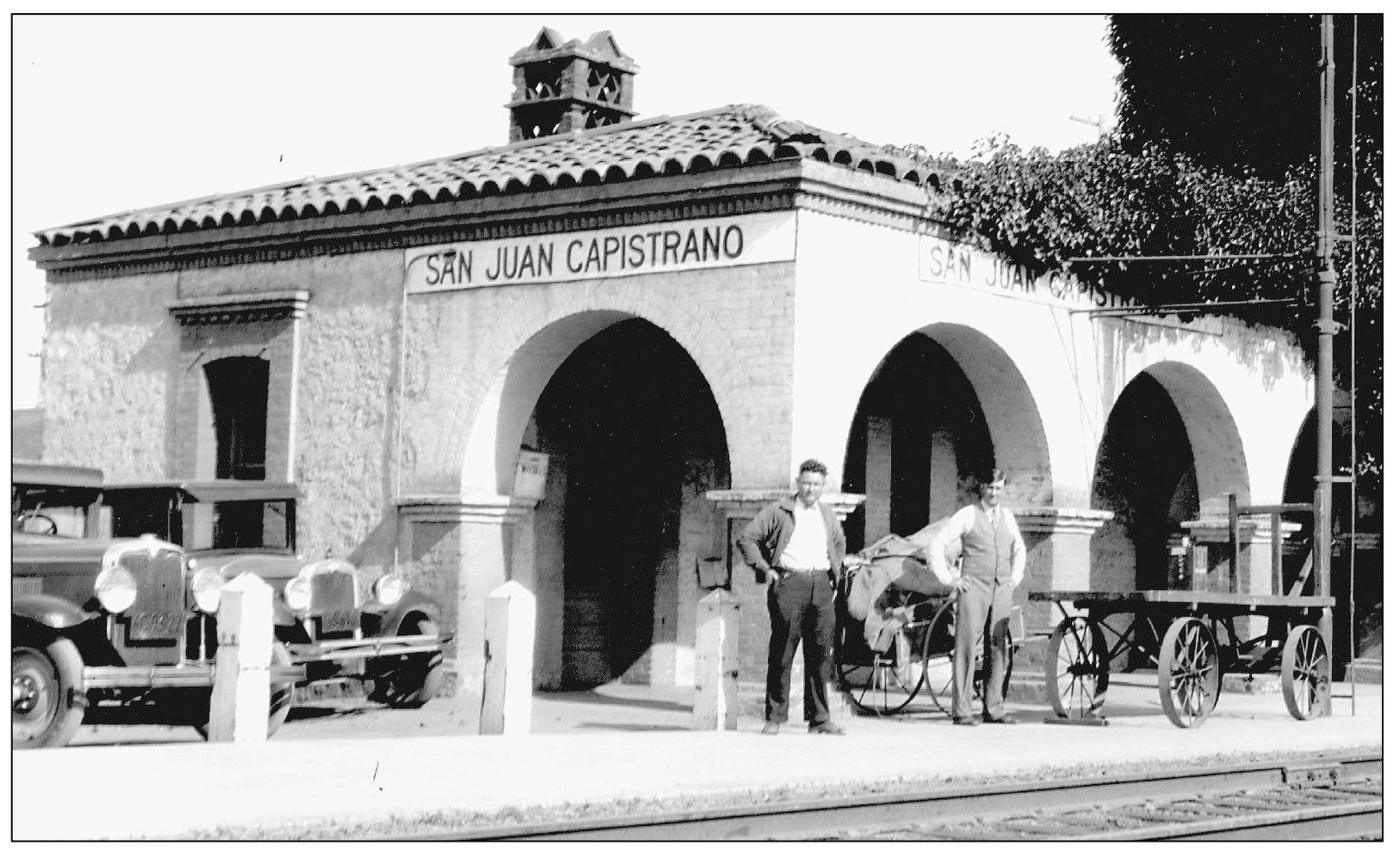
Travel by rail continued to be very popular in the 1930s. The stop’s name was now San Juan Capistrano and while the Hot Springs was no longer the favored destination, there were still fine hotels, a mission with a spectacular garden, an excellent array of restaurants, and the proximity of the beach. These gentlemen wait for the next train with a wagon full of luggage.

This group poses in front of the ruins of the Great Stone Church in the late 1920s. One can only wonder how a motorcar could be driven so close to the ruins. The front of the mission was walled in, but rear portions remained unfenced. Even without the gardens that would make the mission famous, it would have been a bumpy road.

Alfonso Yorba sits with a friend on the edge of the fountain located in the central courtyard of the mission. Yorba was an early historian, a tour guide, and is responsible for reviving interest in early California traditions and folklore. He interviewed many old-timers during the 1930s, took photographs of surviving adobes, and collected many artifacts that still survive.

Mourners attend the reburial of Monsignor St. John O’Sullivan in his beloved mission grounds on November 7, 1934. He was first buried in Calvary Cemetery in Los Angeles after losing his decades-long battle with tuberculosis on July 22, 1933. His grave is on the east side of the Serra Chapel, the original cemetery grounds of the mission.

Fr. Arthur J. Hutchinson, shown with the mission’s famous white pigeons, was born on November 14, 1876, in Brooklyn, New York. He was ordained in 1911 in St. Patrick’s Cathedral. During World War I he served as one of the first chaplains to serve the new Overseas Air Corps where he suffered gas inhalation, and came to California in 1920 for his health. In 1933, he succeeded Monsignor St. John O’Sullivan as pastor of San Juan Capistrano Mission Parish. During his tenure the restoration efforts continued. He walled the entire 10-acre property and continued to reinforce unstable buildings. During his tenure, the story of the swallows’ return was promoted and celebrated for the first time, where thousands of people came to observe the event. He died on July 27, 1951.

Swallows gather mud for their nests. The story of the swallows’ annual return to the mission was first told in Capistrano Nights, a book written by Charles Saunders and published in New York in 1930. The story recounts how the swallows return every year on March 19, which is St. Joseph’s Day. In the book, Acu tells the story to Father O’Sullivan.
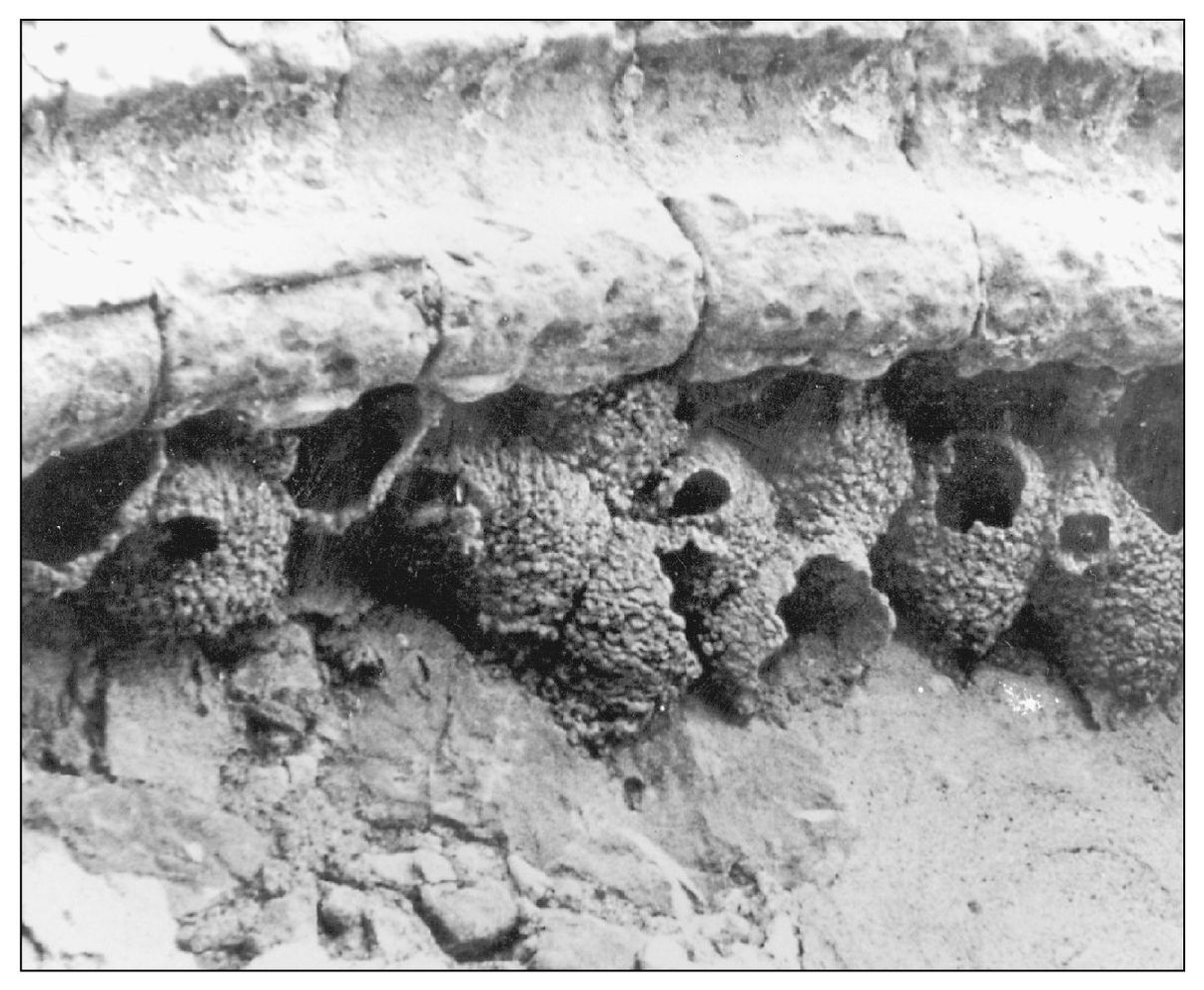
A close-up of swallows’ nests shows how the mud is used. The cliff swallow has short-pointed wings and short, triangular tail feathers. Instead of cliffs, swallows began using the eaves of the mission and in time, eaves of private homes. In 1936, the first radio broadcast of the swallows’ return was made from the mission grounds. The event continues, but swallows are more dispersed because of the crowds.

A close-up of the wall in front of the mission shows stucco and paint over the adobe. The Edward L. Doheny family, who owned property south of town on the coast, donated funds for the work. The mission garden, which was designed and landscaped by Roger B. Sherman in 1934, is not yet in place in this image.
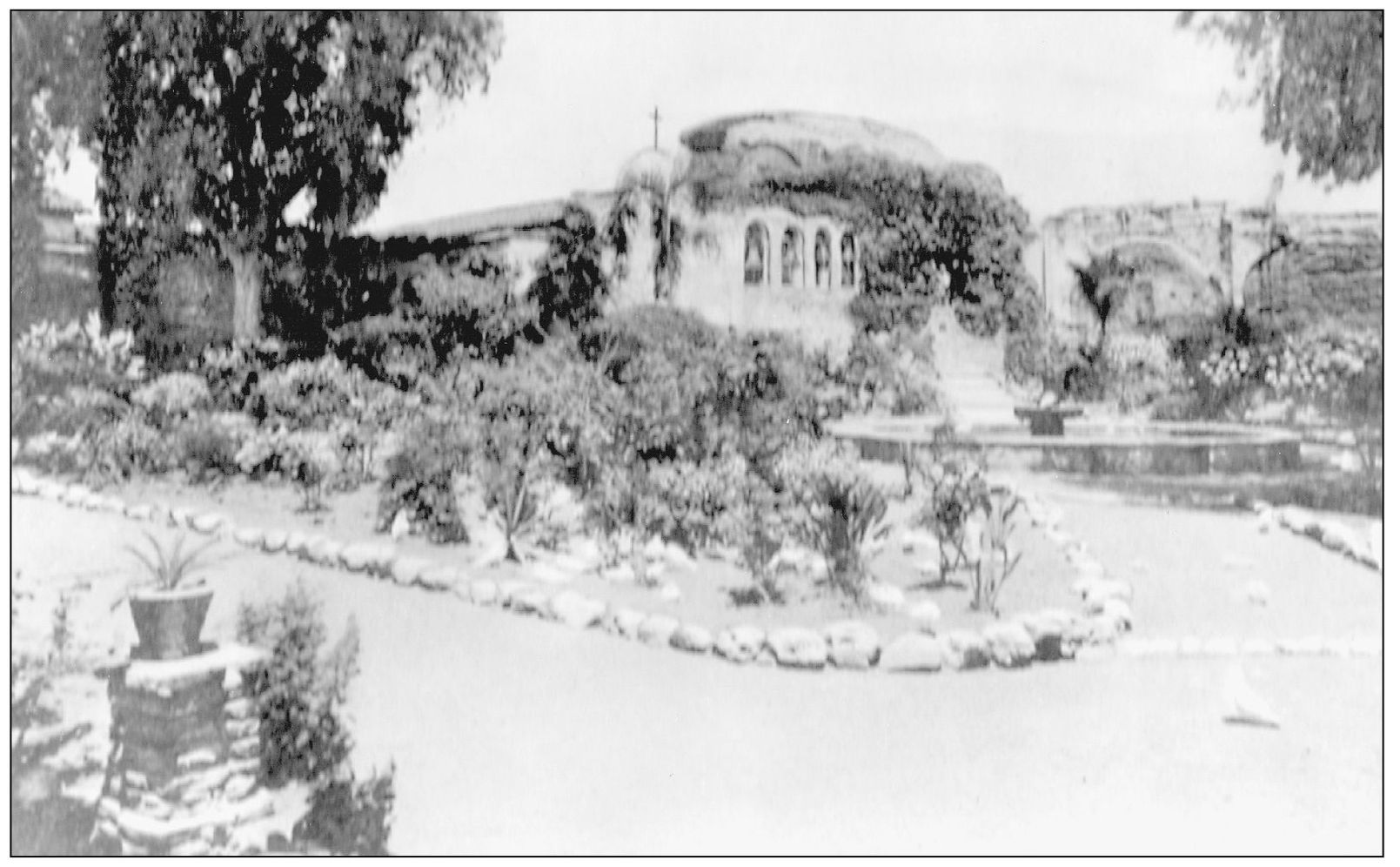
The front courtyard of the mission was a true showplace once the gardens were established. This photograph is from the 1940s and shows a pigeon on the walkway. Visitors could buy packets of food for the pigeons, which were known to gather around and even fly up on shoulders and arms to get the treats. Some misidentify pigeons as swallows.

Downtown San Juan Capistrano in 1930 shows many changes. To the left of the Capistrano Hotel is a new structure, replacing a two-story wood building, and on the left between the two garages is Ferris Kelly’s new store, built in the late 1920s. Kelly became proprietor of the San Juan Hot Springs in 1933, but closed it three years later.

Spring Street, next to San Juan School, still exists as a dead end less than a block long. But at one time it was the main road out of town heading east and was a shortened form of Hot Springs Road. The newly planted orange groves of the Stroschein Ranch are shown, with the dome of the Great Stone Church in the background (center).

With the popularity of the automobile, it was soon evident that a paved road was needed to connect Orange and Riverside Counties. In 1932, a group of prominent citizens and politicians surveyed a possible route for the new Highway 74 linking San Juan Capistrano and Lake Elsinore through the O’Neill Ranch and Cleveland National Forest.

In addition to their technical and political acumen, some members of the survey party for the new Ortega Highway had equestrian skills. This photograph includes John Mitchell, chairman of the Orange County Board of Supervisors, Bill Shumaker, and Willard Smith. The highway was completed in 1934.
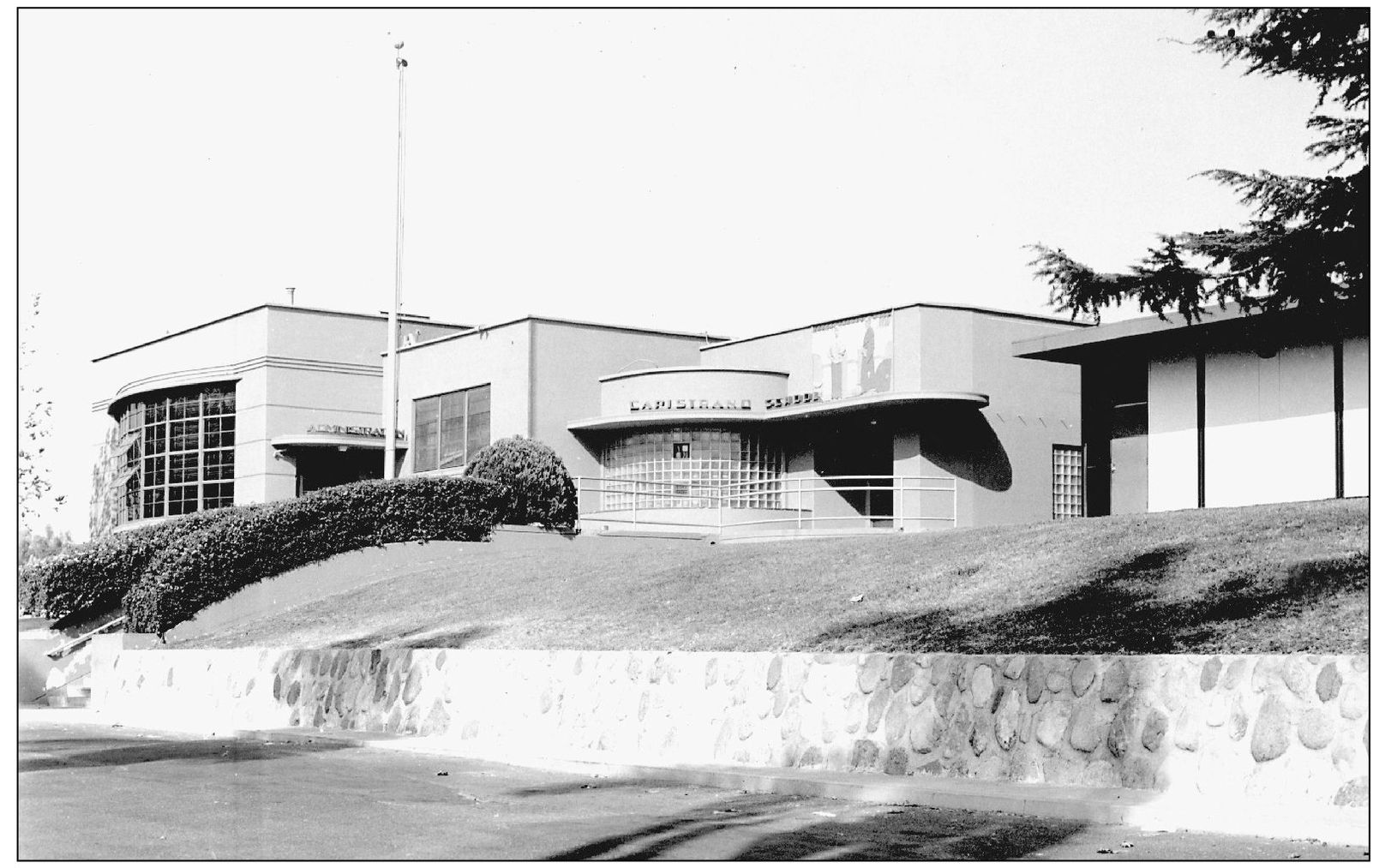
Capistrano Union High School District was formed in 1919. In 1920, 10 acres were purchased north of the mission and several buildings were then constructed in the Spanish Colonial Revival style with tile roofs and stucco walls. In 1938–1939, this modern wing was added in the Streamline Moderne style of architecture. It serves as an adult school today.

The gymnasium for the Capistrano Union High School was built in 1931, where the Capistrano Library stands today. In 1958, building inspectors deemed the building sound, but the others constructed in the 1920s had to be removed. After nine tries, a bond issue passed in 1962 to provide funds to build a new high school in San Clemente.

This is a 1932 image of the Capistrano High School football teams. Pictured, from left to right, are (first row) Bill Olivares, George Larson, Julian Velasquez, and Roy Divel; (second row) Fred Stoffel, Adolph Nieblas, Dale Derian, Joaquin Errecarte, Peter LeGake, Don Pierce, and Aciano Avila; (third row) John Davis, Art Daneri, Edward Lobo, Bill Magee, Chester Lopez, Henry Wattenberg, and George Avila; (top row) Dan Lopez, Malcom Pierce, ? Barry, Myron Guilbert, Stanley Gould (coach), Walter Jackman, Vernon Augustine (coach), Elmer Cook, ? Klaure, and Ernie Reeder.

The Mission Capistrano was a T2-SE-A2 class tanker from the United States World War II building program. The tanker was equivalent of the Liberty ship, as 481 of these 523-foot-long, 20,000-plus ton vessels were built by the United States. It traveled at 16 knots.

In 1932, American Fruit Growers leased 700 acres of the Santa Margarita, Echenique, and Forster ranches to grow eggplant, lettuce, sweet potatoes, and bell peppers. It also announced it would repair the old grain storage building at McKinley (later Verdugo) and the railroad tracks and put 146 people to work.
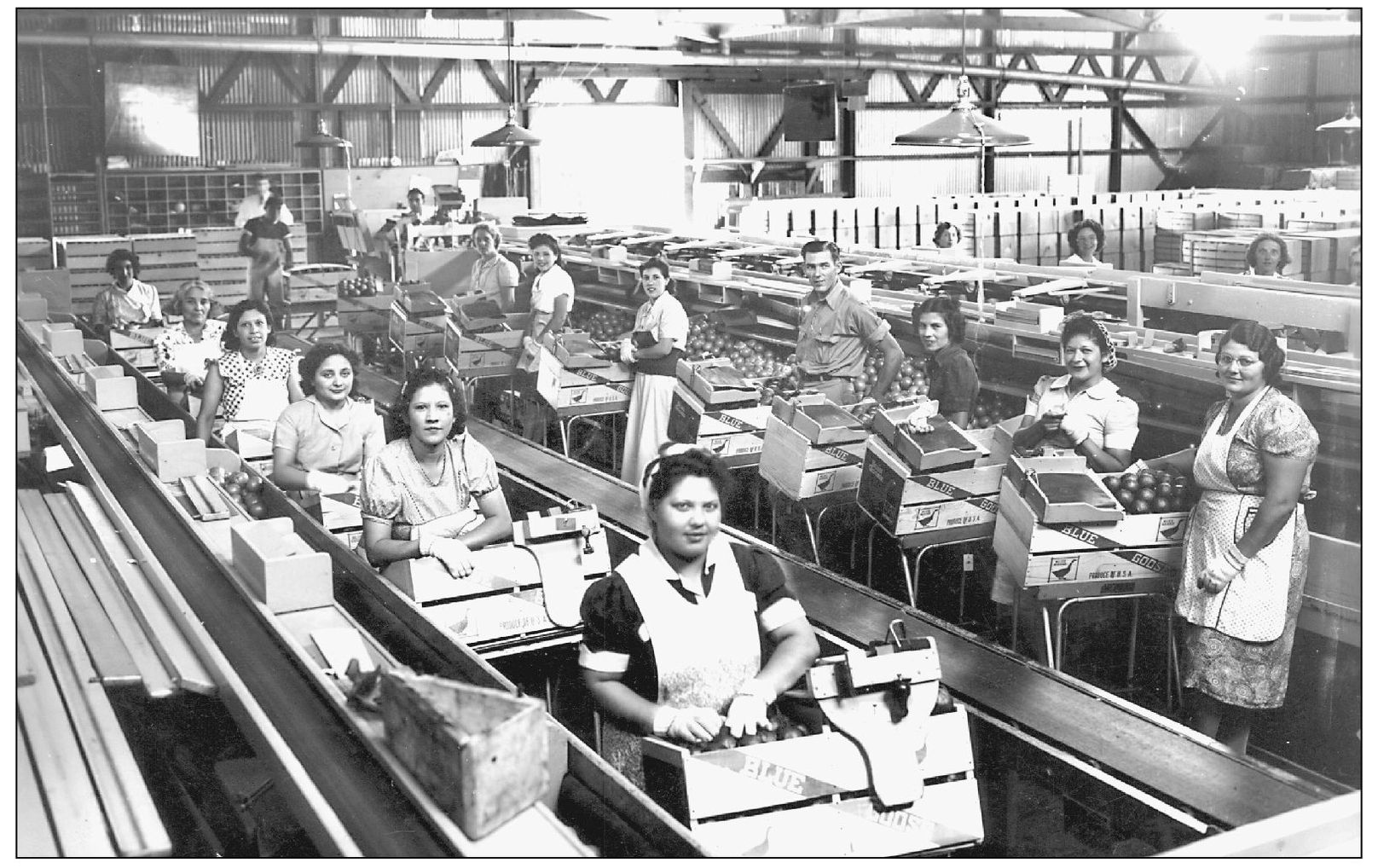
Part of the local workforce at the American Fruit Growers (Blue Goose) packinghouse look up from packing oranges, which was its only crop processed in the early 1940s. By 1932, the valley produced 148,000 boxes and in July 1946 packed a record 3,800 boxes in one day. Production tapered off after the end of the war, and the packinghouse finally closed in 1952.

This panoramic view of the original Capistrano Airport was taken from the air, looking northeast toward distant Saddleback. The original airport opened in 1946, was operated by Fred Stoffel and Bill Webb, and was located on the west side of San Juan Creek. The intersection of Del Avion and Alipaz would be about in the center of the photograph. The Joel Congdon House, later known as the Kinoshita Ranch, is left center and can barely be seen. A 1948 airport guide said it had 1,800 feet of runway, although other publications reduced that length. It was relocated across the creek to the east side in the early 1960s.

A group washes down an airplane at the Capistrano Airport. Planes were used for both recreation and instruction, and the airport was a popular gathering place. A friendly, casual operation, the runway spelled out the words, “Capistrano—come on in” from the air, and the roadway sign stated, “air service with a country atmosphere.”

This photograph shows the buildings and a number of airplanes tied down. Del Avion starts at the left of the image and intersects Alipaz near the top right. Congdon House is visible among the trees. After it relocated, Bruce Winton and the Capistrano Flying Service operated it. It was closed in 1977 after a crash killed a young girl playing in the nearby creek bed.

Marco F. “Tom” Forster rides his horse to work at the Avila Adobe, which served as the justice court. Forster was justice of the peace for San Juan Township from 1938 until 1953. He served 25 years on the San Juan Elementary School Board and was active in many civic organizations. He was serving on the city council when he died in 1966.
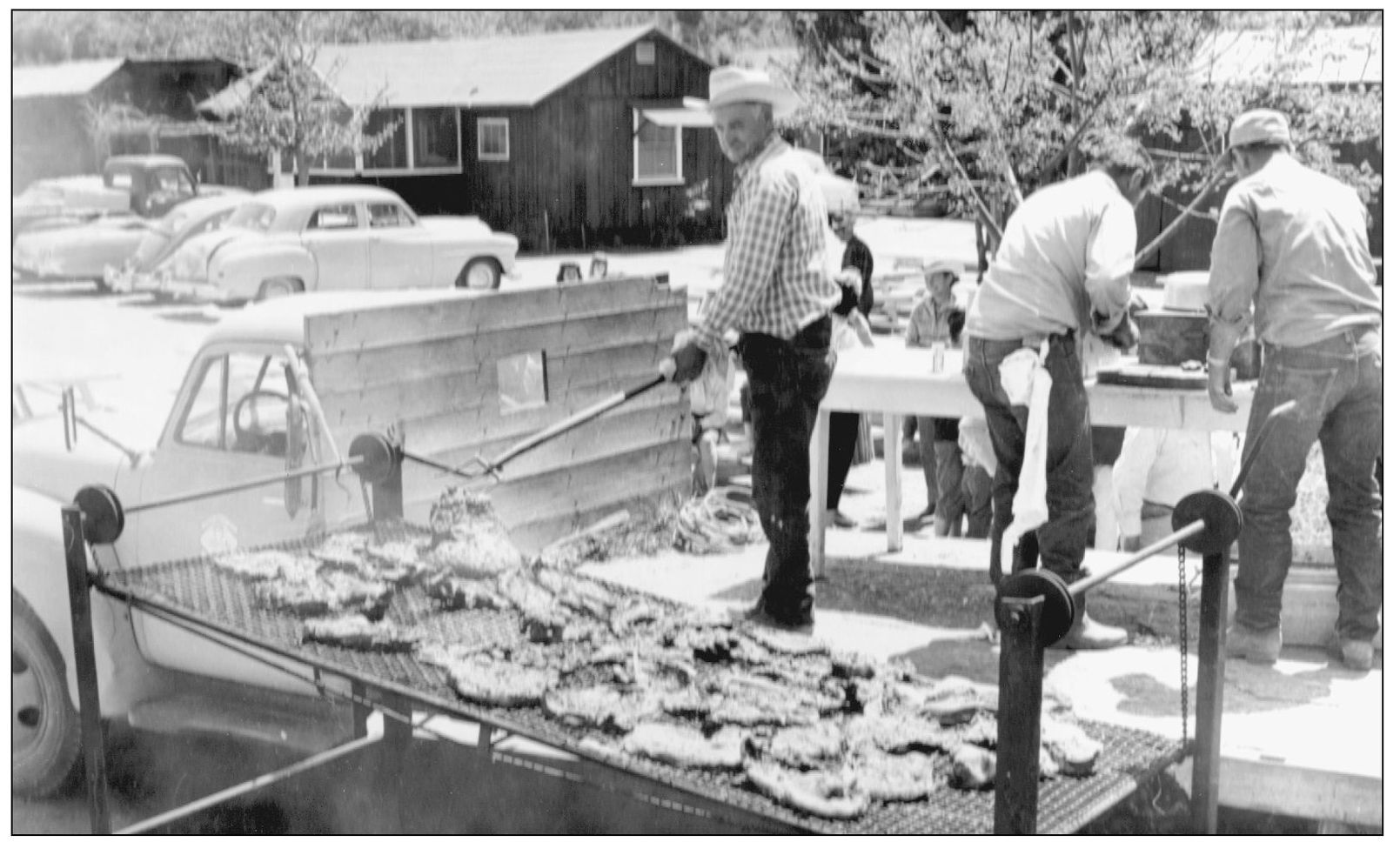
Jack Carrillo turns meat that is being barbecued for the hungry cowboys of Rancho Mission Viejo during one of the roundups in 1964. Roundups were annual rituals to brand calves. The O’Neill family continued the tradition of raising cattle and formed the Santa Margarita Company to operate the 52,000-acre ranch, even after they went into land development in the 1960s.